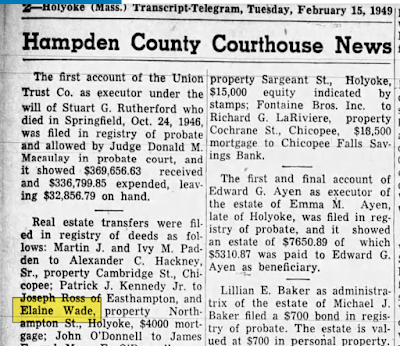Heading north on Route 5, just beyond the Delaney House Restaurant at the intersection of Smith's Ferry Road, is the headquarters of Local 596, Construction and Construction Laborers Union. This building was erected in 1967; however, this topic concerns the business that preceded it: the In-Wee-Go Drive-in.
On Valentine's Day, 1949, Elaine Wade and Joseph Ross purchased land on Northampton Highway from Patrick J. Kennedy Jr., on which they built the In-Wee-Go, a luncheonette and car hop. Holyoke City Directories dating back to 1941 showed this property as vacant. In May 1950, Ross transferred his ownership interest to Elaine Wade.
I could not locate news articles or advertisements about this business's Grand Opening. The first news account appeared in June 1950, when Elaine Wade received approval from the City of Holyoke to renew the common victualer's license for the In-Wee-Go luncheonette.
On November 25, 1952, Nathan Hatez, a restauranteur leasing the Puritan Diner at 1608 Northampton Street, executed a lease to operate the In-Wee-Go Drive-In. Hatez heavily promoted the restaurant through a series of newspaper advertisements. The five-year lease expired at the end of 1956.
In 1958, Elaine Wade transferred the real estate to herself and Winifred Reardon as co-owners. In March 1959, a two-year lease to operate the In-WeeGo was signed by lessee Irving R. Hirshfield. The business name was changed to Hervey's.
In 1962, the real estate was foreclosed and sold to Max C. Krumpholz, who held the mortgage. He was the owner of Pickup Motors Company located on Elm Street.
In 1963, the business was leased to Peter Stathis, and the name reverted to In-Wee-Go. After Peter Stathis, the business was leased to Richard Woodley, who lived in a house trailer on the property. In May 1966, a fire struck the restaurant.
In March 1967, Max Krumpholz sold the real estate to the Trustees of the Construction and General Laborers' Union #596. The ground-breaking for the new Labor Union building occurred shortly thereafter in June. The construction of the union hall was to be completed in two months.
Source of news articles: Newspapers.com (paid subscription), Citations, Holyoke Massachusetts Transcript-Telegram; Publication dates are shown.
































































